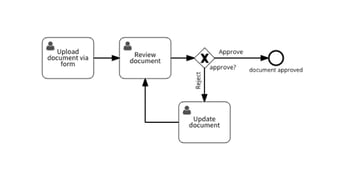BPM (Business process management) can get a bit hazy if you don’t know what you are looking for; so much so that even tech-savvy professionals avoid it.
With their complex notation and steep learning curves, most BPM suites look like specialty software that only a few people on earth know how to use. And, when they hear the price, they know for sure that they’re in the wrong neighborhood.
But with big changes in the industry coming from software advances, SaaS models, and improved UI/UX, is it time that you took another look at a business process management suite?
Let’s look at the truth behind some common misconceptions in order to gauge how BPM software can make an impact on your business.
“BPM Is Rocket Science”
The wireframe of Wright Brother’s flight prototype was a jumbled mess; most of Hemingway’s classics had glaring language errors in their first drafts; and we all have witnessed the evolution of mobile phones, from looking like paver blocks to being sleek smartphones with supercomputer capabilities.
As any veteran IT professional would tell you, BPM solutions in the early days were undoubtedly clunky. But they have come a long way since the time when you had computers the size of hydraulic trucks.
Today’s BPM platforms are built on the cloud and made for simplicity. You can even use BPM software to automate simple, recurring processes. Thanks to the no-code, human-centric BPM systems nowadays, it won’t be long before everyone can run processes on their own.
“BPM Suites Cost a Bomb”
It’s natural for many enterprises to worry about stretching their IT budget in order to accommodate a new BPM software in their ledger book. But what they don’t understand is that the ROI of automating your business processes through a BPM tool is hugely beneficial in the long run; rather than letting them get tangled in a perpetual chaos of manual workflows.
To be fair, on-premise BPM systems do generally cost a bomb. But most of today’s leading BPM platforms are cloud-based and follow a SaaS model of doing business. That means they come with flexible pricing plans, charging you only for the number of user licenses you want for your enterprise. You’ll not be paying the same amount that Coca Cola Co. or AT&T is paying.
This is the primary reason why cloud business process management suites have given the traditional on-prem BPM software a run for the money. With business automation software, companies can unify fragmented processes, eliminate redundancies, and ensure consistent execution across departments. This creates a foundation for scalable operations and better decision-making at every level.
“It’s A High Maintenance Commitment”
At best, BPM platforms require you to monitor your automated process, understand the reports, and make changes to the workflow if needed. All those are things are related to the process, but nothing about the BPM system itself.
A new age BPM system on-cloud is nowhere close to the attention a legacy software demands from its beneficiaries. Automating processes with a BPM tool follows the simple set-it-and-forget-it mantra. Cloud vendors take care of everything such as data storage, security, updates, versioning, and the works.
The only thing your business needs to invest is in the one-time initial startup cost and the monthly billing. Unlike running other ERP software, you don’t have to worry about training your staff on the technicalities, setting up a new server space, hiring a consultant, etc.
“BPM Requires Operational Metamorphosis”
BPM is an efficiency-enabler tool to help enterprises achieve their productivity and profit goals. Unlike other business solutions that require businesses to change their tack and reorganize some of their processes, a BPMS adds value to the existing processes by slashing costs and cutting redundancies.
An intelligently-built BPM product fits an enterprise processes like a glove and improves their performance by a significant margin. The agile cloud BPM software is designed to mirror the pre-existing processes and speak in the same language that the process users understand.
A BPM system is a catalyst that accelerates the process and productivity, without distorting the essential process components. BPM is not a one-size-fits-all solution; it’s a flexible discipline that can mould on top of any generic process from any industry.
“Adopting BPM Means Losing Jobs”
One of the biggest insecurities against BPM is that it displaces humans from the workforce by automating processes. While it’s sounds like something that makes up for an interesting sci-fi movie plot, the real-world application of BPM is far from threatening to the human workforce.
A computer is good at processing, recording, and retrieving data, some areas where humans are prone to do mistakes or even fail. Humans, on the other hand, trump computers when it comes to making certain judgements and human-sensitive decisions. In that sense, BPM is simply letting systems handle complex number-churning tasks, while the human workforce can be free to take up more qualitative things like interpreting data, evaluating choices, or planning business strategies.
BPM does not force people out of their jobs, but creates new and more intelligent jobs for them to apply their skills to, where machines can’t compete.
There are even more myths about the fear of adopting a BPM system that are making rounds in enterprise circles, including IT departments. Once you resolve to dissect the fact behind these assumptions, you will see that these are nothing but hand-me-down stories that have been passed down by the early BPM users.
To see how easy it can be to automate complex tasks in your organization through a BPM Suite, we welcome you to try Kissflow Process. It’s a cloud-based platform with more than 50 pre-built enterprise workflow apps, and you can try it for 30-day for absolutely no cost!








.webp?width=285&height=570&name=process-management-banner%20(15).webp)




